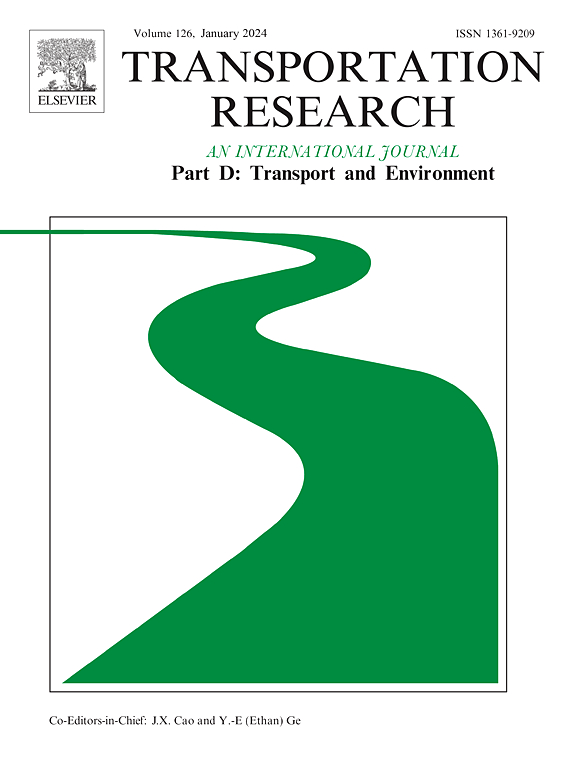通过大间距卡车队列行驶减少燃料消耗和尾气氮氧化物排放
IF 7.7
1区 工程技术
Q1 ENVIRONMENTAL STUDIES
Transportation Research Part D-transport and Environment
Pub Date : 2025-07-31
DOI:10.1016/j.trd.2025.104917
引用次数: 0
摘要
为了在丘陵地形的公共道路上实现安全高效的卡车队列行驶,本研究开发了一种创新的控制器,该控制器使用了来自道路队列行驶试验的真实卡车数据。设计的控制器在保持安全间距的同时节省燃料,最大限度地减少尾气氮氧化物(NOx)的排放。利用基于实验数据的验证模型对实现该控制器的双车排进行了仿真。结果表明,所设计的控制器有效地将间距误差限制在预设的安全缓冲区内。即使在时间间隔超过2秒的情况下,在艾伯塔省2号公路不同道路等级的驾驶循环下,跟随卡车也能减少23.2%的氮氧化物排放,节省6.6%的燃油。这些好处源于抑制快速的发动机扭矩波动和减少不必要的减速和加速。该研究强调了在现实条件下大间距卡车队列行驶的可行性,在确保安全的同时优化燃油消耗和排放。本文章由计算机程序翻译,如有差异,请以英文原文为准。
Reducing fuel consumption and tailpipe nitrogen oxides emissions through large-spacing truck platooning
To enable safe and efficient truck platooning on public roads with hilly terrain, this study develops an innovative controller using real-world truck data from the on-road platooning trials. The designed controller maintains safe spacing while simultaneously saving fuel and minimizing tailpipe nitrogen oxides (NOx) emissions. A two-truck platoon implementing the controller is simulated using validated models based on experimental data. The results show that the developed controller effectively limits spacing errors within a preset safety buffer. Even at time gaps exceeding 2 s, the follower truck achieves up to a 23.2% reduction in NOx emissions and a 6.6% fuel saving under the Alberta Highway 2 driving cycle with varying road grades. These benefits stem from suppressing rapid engine torque fluctuations and minimizing unnecessary decelerations and accelerations. This study highlights the feasibility of large-spacing truck platooning in real-world conditions, ensuring safety while optimizing fuel consumption and emissions.
求助全文
通过发布文献求助,成功后即可免费获取论文全文。
去求助
来源期刊
CiteScore
14.40
自引率
9.20%
发文量
314
审稿时长
39 days
期刊介绍:
Transportation Research Part D: Transport and Environment focuses on original research exploring the environmental impacts of transportation, policy responses to these impacts, and their implications for transportation system design, planning, and management. The journal comprehensively covers the interaction between transportation and the environment, ranging from local effects on specific geographical areas to global implications such as natural resource depletion and atmospheric pollution.
We welcome research papers across all transportation modes, including maritime, air, and land transportation, assessing their environmental impacts broadly. Papers addressing both mobile aspects and transportation infrastructure are considered. The journal prioritizes empirical findings and policy responses of regulatory, planning, technical, or fiscal nature. Articles are policy-driven, accessible, and applicable to readers from diverse disciplines, emphasizing relevance and practicality. We encourage interdisciplinary submissions and welcome contributions from economically developing and advanced countries alike, reflecting our international orientation.

 求助内容:
求助内容: 应助结果提醒方式:
应助结果提醒方式:


